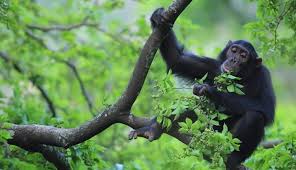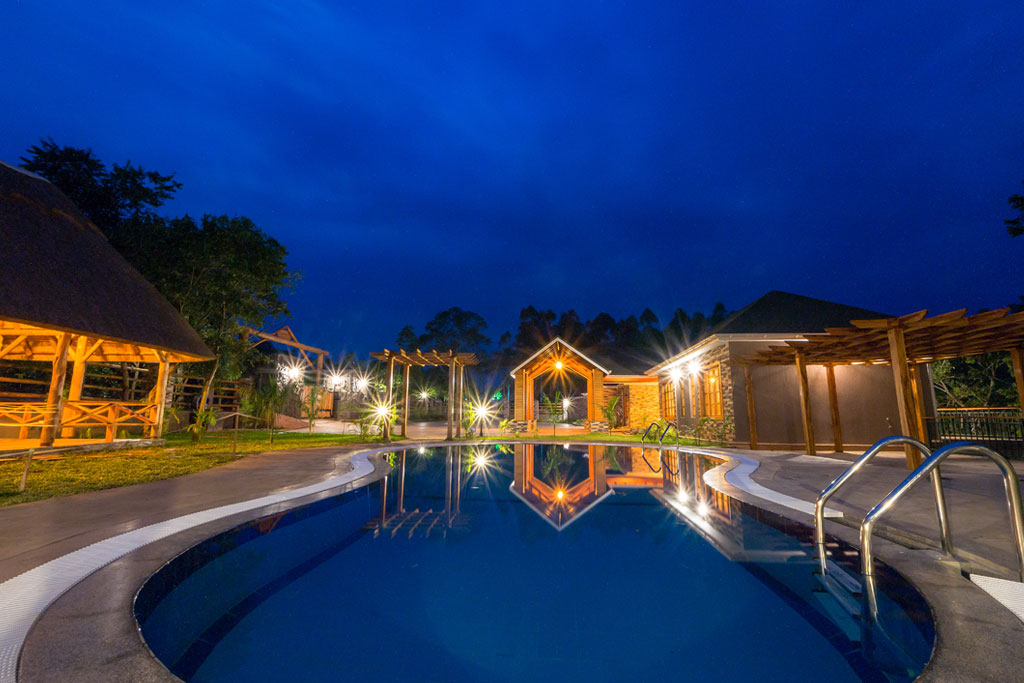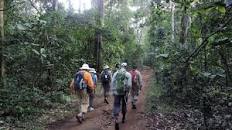Kibale National Park in Uganda is a haven for primate enthusiasts, particularly those seeking the thrilling experience of chimpanzee trekking. With its lush forests and diverse wildlife, Kibale offers a unique opportunity to encounter our closest relatives in their natural habitat. As you embark on this adventure, it’s natural to have questions. In this article, we will provide detailed answers to some of the most frequently asked questions about chimpanzee trekking in Kibale, ensuring you’re well-prepared for an unforgettable encounter with these remarkable creatures.
What is chimpanzee trekking?

Chimpanzee trekking is an immersive wildlife experience that involves tracking and observing wild chimpanzees in their natural habitat. Accompanied by experienced guides, visitors venture into the forests of Kibale National Park to locate and spend time with habituated chimpanzee communities. It allows for close encounters with these intelligent primates, offering insights into their behavior, social dynamics, and conservation efforts.
Where is Kibale National Park located?
Kibale National Park is nestled in the southwestern part of Uganda, covering an area of approximately 795 square kilometers. It is located in the districts of Kabarole and Kamwenge, about 320 kilometers by road from Kampala, the capital city of Uganda.
How can I reach Kibale National Park?
To reach Kibale National Park, visitors typically fly into Entebbe International Airport in Uganda and then travel by road to the park. Domestic flights are available from Entebbe to Kasese Airstrip, which is the closest airport to Kibale. From there, it’s a scenic drive to the park entrance. Alternatively, you can hire a private vehicle or join a guided tour from Kampala or other major cities.
How long does a chimpanzee trekking experience usually last?
A typical chimpanzee trekking experience in Kibale lasts between two to four hours, depending on various factors such as the location of the chimpanzee community and their current behavior. The trek itself involves hiking through the forest, following the guidance of skilled trackers until the chimpanzees are located.
What is the best time of year to go chimpanzee trekking in Kibale?
The best time to go chimpanzee trekking in Kibale is during the drier months of the year, which are from December to February and June to September. These months offer more favorable trekking conditions with less rainfall, making it easier to navigate the forest trails. However, Kibale’s rainforests are beautiful year-round, and even during the wetter months, the chances of encountering chimpanzees remain high.
Are there age restrictions for chimpanzee trekking?
To ensure the safety of both visitors and chimpanzees, age restrictions are in place for chimpanzee trekking in Kibale. Generally, the minimum age requirement is 12 years old. This restriction helps minimize disturbance to the primates and ensures that participants can handle the physical demands of the trek.
How physically demanding is chimpanzee trekking in Kibale?
Chimpanzee trekking in Kibale involves moderate physical activity, including hiking on uneven terrain and sometimes steep slopes. While the difficulty level can vary depending on the specific chimpanzee group being tracked, a reasonable level of fitness is recommended. It is advisable to consult with your tour operator or guide if you have any concerns about your physical abilities.
Do I need to book in advance for chimpanzee trekking permits?
Yes, it is essential to book your chimpanzee trekking permits in advance. The number of permits issued per day is limited to minimize the impact on the chimpanzee communities. Permits can be obtained through the Uganda Wildlife Authority or authorized tour operators. It’s recommended to book your permits well ahead of time, especially during the peak tourist seasons.
How much does a chimpanzee trekking permit cost in Kibale?
The cost of a chimpanzee trekking permit in Kibale National Park varies depending on the season and nationality. As of 2021, the permit fee for foreign non-residents is $200 per person, $150 for foreign residents, and UGX 150,000 for East African residents. These fees contribute to conservation efforts and local community development initiatives.
How many people are allowed in a group during chimpanzee trekking?
To minimize disturbance to the chimpanzees and ensure an intimate experience, a maximum of eight visitors are allowed per chimpanzee trekking group. This limitation helps maintain a peaceful environment for the primates and allows for better observation and photography opportunities.
What is the success rate of seeing chimpanzees during a trek?
The success rate of encountering chimpanzees during a trek is generally high in Kibale National Park. The park is home to numerous habituated chimpanzee communities, increasing the chances of successful sightings. However, as chimpanzees are wild animals, their movements can be unpredictable, and there is no guarantee of an encounter. The expertise of the guides and trackers greatly enhances the likelihood of finding the chimpanzees.
What should I wear and pack for chimpanzee trekking in Kibale?
For chimpanzee trekking in Kibale, it is recommended to wear sturdy, comfortable clothing suitable for hiking, including long pants, long-sleeved shirts, and sturdy walking shoes or boots. It’s advisable to bring a waterproof jacket, hat, sunscreen, insect repellent, and a small backpack to carry water, snacks, and camera equipment. It’s crucial to respect the guidelines provided by the park authorities and ensure you don’t leave any litter behind.
Are there any safety precautions or rules to follow during chimpanzee trekking?
Yes, there are specific safety precautions and rules to ensure the well-being of both visitors and chimpanzees. It is crucial to maintain a minimum distance of seven meters from the chimpanzees to avoid any potential transmission of diseases. Flash photography is prohibited to prevent distressing the animals, and visitors must follow the instructions of the guides at all times. Silence is often encouraged to create a peaceful environment during the trek.
Can I take photographs or videos during the chimpanzee trek?
Yes, photography and videography are allowed during chimpanzee trekking in Kibale. However, the use of flash photography is strictly prohibited to prevent any disturbance or stress to the chimpanzees. Respectful photography, with the guidance of your tour guide, ensures a memorable and responsible wildlife encounter.
Are there any other wildlife species I can expect to see during the trek?
While chimpanzees are the highlight of the trek, Kibale National Park is home to a diverse array of wildlife. As you navigate through the forest, you may encounter other primates such as red-tailed monkeys, black-and-white colobus monkeys, and vervet monkeys. The park also hosts a rich variety of bird species, butterflies, and smaller mammals, providing a delightful experience for nature lovers.
Are there any accommodations available near Kibale National Park?

There are several accommodation options available near Kibale National Park, ranging from luxury lodges to budget-friendly guesthouses. These establishments provide comfortable lodging, delicious meals, and knowledgeable staff who can assist with organizing your chimpanzee trekking experience. Popular accommodation choices include Kibale Forest Camp, Primate Lodge Kibale, and Ndali Lodge.
Are there any additional activities or attractions in Kibale National Park?

Kibale National Park offers more than just chimpanzee trekking. Visitors can engage in various activities such as guided nature walks, birdwatching, nocturnal forest walks, and visits to nearby Bigodi Wetland Sanctuary, which is renowned for its birdlife and primate species. The park’s beautiful landscapes and vibrant ecosystems make it a paradise for nature enthusiasts.
Are there any health requirements or vaccinations needed for visiting Kibale?
Before traveling to Kibale National Park, it is advisable to consult with a healthcare professional or a travel clinic for up-to-date information on recommended vaccinations and health precautions. Vaccinations such as yellow fever, typhoid, hepatitis A, and tetanus are often recommended. It’s essential to carry insect repellent to protect against mosquito bites and take necessary precautions to prevent waterborne illnesses.
Can I visit the chimpanzees if I have a cold or other illnesses?
To protect the chimpanzees from potential infections, visitors with contagious illnesses such as colds, flu, or other transmissible diseases are usually not permitted to participate in chimpanzee trekking. This precaution helps safeguard the health and well-being of both humans and chimpanzees. If you’re unwell, it’s best to reschedule your visit for a time when you have fully recovered.
What conservation efforts are in place to protect the chimpanzees in Kibale National Park?
Kibale National Park and the surrounding communities are actively involved in conservation initiatives to protect the chimpanzees and their habitat. These efforts include research, community outreach, anti-poaching measures, and sustainable tourism practices. By visiting Kibale and supporting responsible tourism, you contribute to the conservation of these incredible primates and their fragile ecosystem.
Conclusion
Chimpanzee trekking in Kibale National Park offers a remarkable opportunity to witness the beauty and complexity of our closest relatives in their natural environment. By addressing the frequently asked questions about chimpanzee trekking, we hope to have provided you with a comprehensive understanding of what to expect, ensuring that your adventure in Kibale is memorable, informative, and respectful towards the fascinating chimpanzee communities that call this park home. Remember to prepare well, follow the guidelines, and embrace the wonders of the forest for an unforgettable primate encounter.
